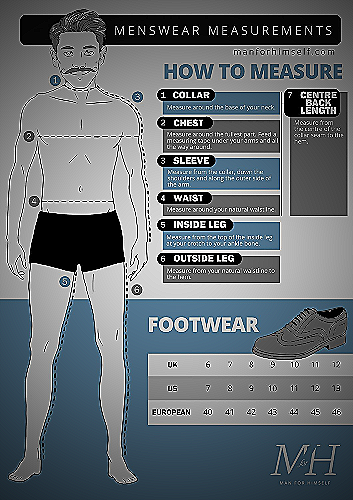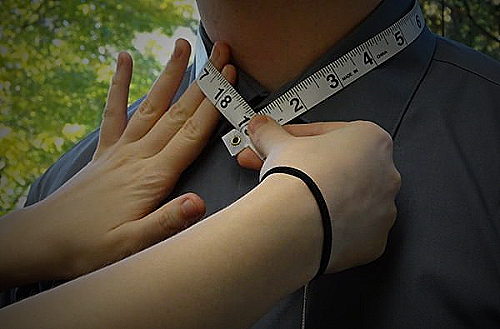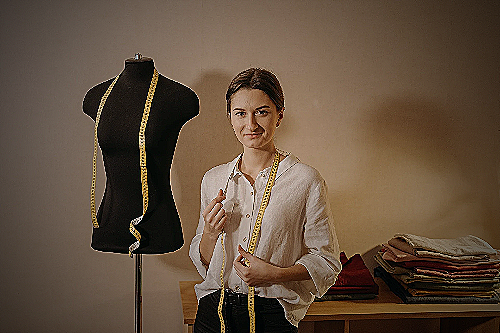Understanding the importance of having perfectly fitted clothes is crucial in the modern world. This article provides a comprehensive guide on how to take men’s measurements for a perfect fit.
Measuring the Chest
To measure the chest, wrap the tape measure underneath the armpits and around the fullest part of the chest. Make sure the tape measure is straight and snug but not too tight, and take note of the measurement in inches.

Measuring the Waist
Traditionally men‘s waists are measured at the natural waistline, just above the belly button. To find the natural waist, have the person bend to the side and observe the natural crease that forms.
Place the tape measure at this point and wrap it around the waist, making sure it’s snug but not too tight. Note the measurement in inches.

Are you tired of ill-fitting clothes? Want to ensure you purchase the right size every time?
Check out this Youtube video: “How To Properly Take Men’s Clothing Measurements” for foolproof tips on measuring yourself for the perfect fit!
The Importance of Taking Accurate Measurements
When it comes to buying clothes, taking accurate measurements is crucial. This is especially true for men‘s clothing, where getting the right fit can make all the difference.
Clothes that are too tight or too loose can be uncomfortable to wear, and can even give off an unprofessional look.
Accurate measurements are also important for more customized clothing options such as suits and dress shirts. Tailors and custom clothing companies will often require specific measurements to ensure that the finished product fits properly.
Overall, taking accurate measurements is the foundation for making informed decisions about clothing purchases and achieving a comfortable and polished look.
Tools Needed
When it comes to taking men’s measurements, having the right tools is crucial for getting accurate results. Here are some of the common tools you will need:
- Measuring tape – This is the most basic tool for taking measurements. Look for a sturdy tape measure that is at least 60 inches long. Some measuring tapes also come with lockable features which can be helpful for taking solo measurements.
- Calipers – For more precise measurements of the body, calipers are a great addition to your toolkit. They can measure small areas like the collarbone or bicep with more accuracy than a measuring tape.
- Height measuring tool – To measure a man’s overall height, consider investing in a height measuring tool which can be attached to a wall or door frame.
- Scale – Although not necessarily a measuring tool, weighing yourself regularly can give you an indication of your overall health and body composition.
By having the right tools on hand, you can ensure that you get precise and accurate measurements for the best fit and most comfortable clothing.
How to Take Men’s Measurements
If you want to ensure a perfect fit when buying clothes, taking your own measurements is key. Accurate measurements are the foundation of reliable decision-making, so being able to access measurement data helps support data-driven choices throughout the project life cycle.
In this article, we will guide you on how to take men’s measurements for a perfect fit.
1. Collar
The collar measurement is easy to take. Use a measuring tape to circle the neck where the collar sits.
This should be just below your Adam’s apple. Make sure to keep the measuring tape straight and not too tight or too loose.
Add 1/2 inch to this measurement to ensure a comfortable fit. This is your collar size.
2. Chest
To measure the chest, wrap the measuring tape around the fullest part of the chest, under the armpits and over the shoulder blades. Make sure the tape is snug but not too tight.
Keep your arms relaxed at your sides. This is your chest measurement.
3. Sleeve
To measure your sleeve length, place your hand on your hip with your elbow bent at a 90-degree angle. Measure from the middle of the back of your neck across your shoulder and down your arm to your wrist.
This is your sleeve length measurement.
4. Waist
To measure the waist, stand naturally and bend to one side. The crease that forms is your natural waistline.
Wrap the measuring tape around your waist, making sure it is straight and snug. Add 1 inch to this measurement to ensure a comfortable fit.
This is your waist measurement.
5. Inseam
To measure the inseam length, stand straight with your feet approximately shoulder-width apart. Measure from your crotch to your ankle bone.
This is your inseam length measurement.
6. Hips
Wrap the measuring tape around the fullest part of your hips, making sure it is straight and snug. This is your hip measurement.
7. Shoulder
Measure from the joint where your neck meets your shoulder to the point of your shoulder. This is your shoulder width measurement.
8. Thigh
Wrap the measuring tape around the fullest part of your thigh. This is your thigh circumference measurement.
9. Outseam
To measure the outseam, stand straight with your feet approximately shoulder-width apart. Measure from your waistband or natural waistline to your ankle bone, following the curve of your leg.

Frequently Asked Questions
Where should men's waists be measured?
What are some common types of measuring tools?
How do you measure the waist?
What are the steps to measure men's clothing?
Why is accurate measurement important?
How to Take Men’s Measurements: A Beginner’s Guide
Proper measurements are essential to getting perfectly fitted clothes. Whether you’re a man getting ready to suit up for an upcoming event or a tailor trying to create bespoke pieces, knowing how to take men’s measurements accurately is essential.
The Tools You’ll Need
Before you start measuring, make sure you have the following tools:
- Measuring tape
- Pen and paper to record measurements
- A mirror or a friend to help
Measuring Tips
Follow these basic steps and tips:
- Stand up straight with your feet shoulder-width apart.
- Do not hold your breath or suck in your stomach while measuring.
- Make sure the tape measure is snug but not too tight.
- Measure over the underwear – not over the clothes.
Measurements to Take
Here are the most common measurements you’ll need for men‘s clothing:
